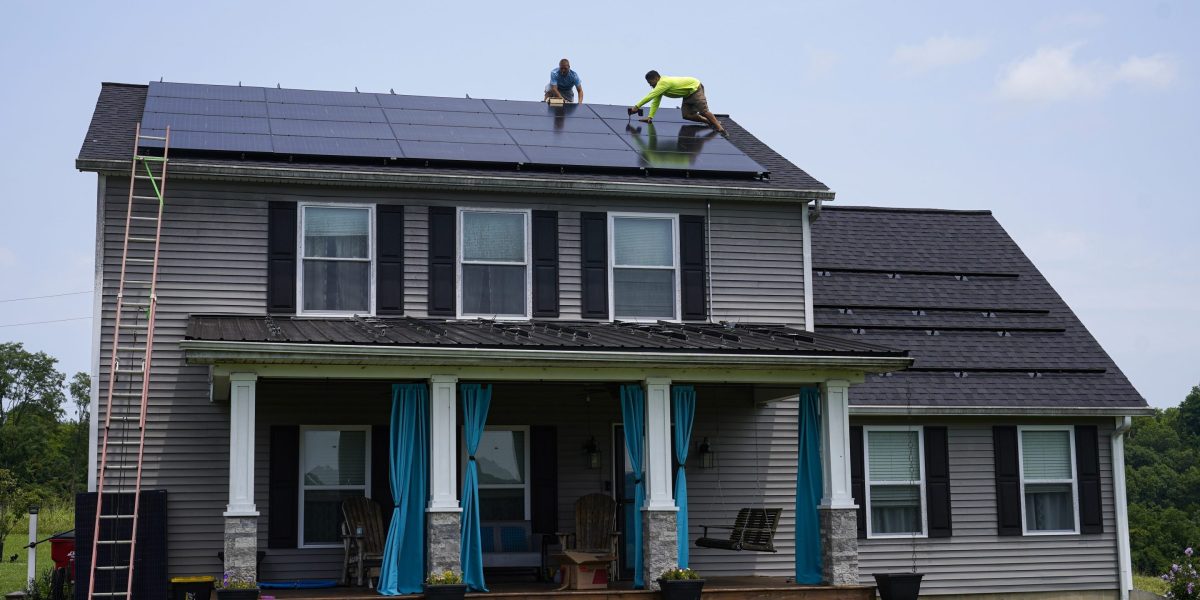Solar rooftops gain traction as electric vehicles owners look to skip paying for electricity or gasoline: ‘Solar just makes sense’::Residential solar is gaining traction in the U.S., with about 4.5 million homes now with solar rooftops.
Electric vehicles use a huge amount of power that many solar systems may not be able to accommodate, in addition to the regular usage load of the house. Keep in mind that the electrification dream is to also run HVAC and hot water off of electricity too. Also, in terms of charging your car, you’ll usually be at home charging overnight when the sun isn’t out. Sure, you can install a battery to charge from, but the capacity of these power walls is puny compared to the needs of an electric car. Also, you may want to use some of it for your actual house.
Not saying we shouldn’t try at home solar or that it won’t work for some folks, but it’s not a silver bullet. A lot of people will still be drawing from the grid, even with solar and back up batteries.
Electric vehicles use a huge amount of power
Eh, not that huge. Summertime AC electrical consumption is about triple what my monthly EV home charging consumes.
that many solar systems may not be able to accommodate,
This is true that many are smaller systems (say 8kw or so of installed capacity). However, unless you’re an extremely heavy use EV driver, you’re not likely draining your EV battery flat everyday. Many folks may only be using 10%-30% or less for their daily driving. This represents 3-5 hours of “middle grade” home EV charging current (ballpark of 25A-30A at 240v AC charging).
in addition to the regular usage load of the house.
Even most Solar PV installs aren’t 100% replacement of household electrical consumption.
Keep in mind that the electrification dream is to also run HVAC and hot water off of electricity too. Also, in terms of charging your car, you’ll usually be at home charging overnight when the sun isn’t out.
This is where different state laws come in and make it weird and not a one-size-fits-all answer. For many states (like mine) I have “1 to 1 net metering” meaning if I push 1kw of electricity to the grid because I’m generating more than I need at that time, I can later pull that 1kw back from the grid when my generation is lower or my demand is higher and its a net zero cost to me. So if I push 8kw to the grid during the bright sunny day over what I’m consuming in my home, I can put that 8kw back into the EV at night charging and its like I put it in a battery.
There are some states moving away from 1 to 1 net metering or even less advantageous ratios like 1:2.
Sure, you can install a battery to charge from, but the capacity of these power walls is puny compared to the needs of an electric car. Also, you may want to use some of it for your actual house.
Agreed. For some numbers, a single Tesla Powerwall charged to 100% would be able to charge a Tesla Model 3 Long Range from 0% to about 33% before the Powerwall would be empty.
Not saying we shouldn’t try at home solar or that it won’t work for some folks, but it’s not a silver bullet. A lot of people will still be drawing from the grid, even with solar and back up batteries.
Nothing is a silver bullet that matches everyone’s consumption and house solar capacity. The cool part is nothing needs to be. Even a partial benefit is a benefit. With the government incentives, the Solar PV system I’m getting will have full payback of the cost in about 7-10 years. After that I’ll still be generating 95%-ish of the rated value of the panels, but have another 15-25 years of nearly free electricity*.
I’m also getting small battery capacity because of more frequent difficulties with electrical outages, but they are NOT cost effective. However, my need isn’t about cost for the batteries but instead high need of constant electrical availability.
*nearly free because I’m counting on a few small things breaking and needing to be replaced or serviced.
Fast-charging an EV for an hour would use the same amount of electricity a home would likely use in a day.
The government should use satellite imaging to locate all the rooftops and parking lots most suitable for photovoltaic panels and lease those spaces from the property owners to install them. The generated electricity would belong to the government to sell to the grid, but the property owners would be allowed to use the panels for backup power if they get disconnected from the grid because bad weather and whatnot. Anyone that declines the offer gets taxed on the imputed rent.
This is the best summary I could come up with:
Less than a year later, motivated to take more action to address climate change, he said, Selgo bought his first electric vehicle, a Nissan Leaf.
It’s an important point because electricity production and transportation are the largest two sources of greenhouse gas emissions, and therefore climate change, in the U.S., according to the Environmental Protection Agency.
Several legacy car companies are launching efforts to connect customers with energy services, including solar installation contractors.
About half of households in the U.S. either don’t have control over their roof, or find that it’s not adequate because of location, space or orientation, according to the DOE solar office.
The Inflation Reduction Act, which President Joe Biden signed into law in August 2022, allows consumers to claim 30% of what they put into their system as a credit on their next federal tax bill.
Selgo said his system cost $19,500, but after receiving the 30% federal tax rebate and $1,000 from the state of Arizona at the time, he ultimately paid out around $12,500.
The original article contains 886 words, the summary contains 168 words. Saved 81%. I’m a bot and I’m open source!
deleted by creator





